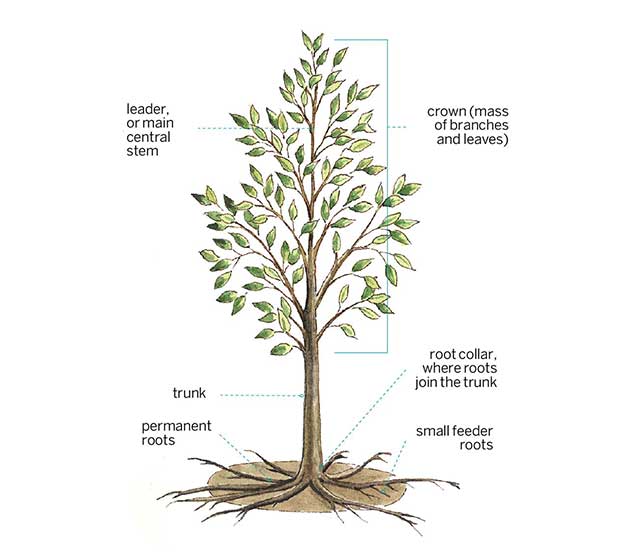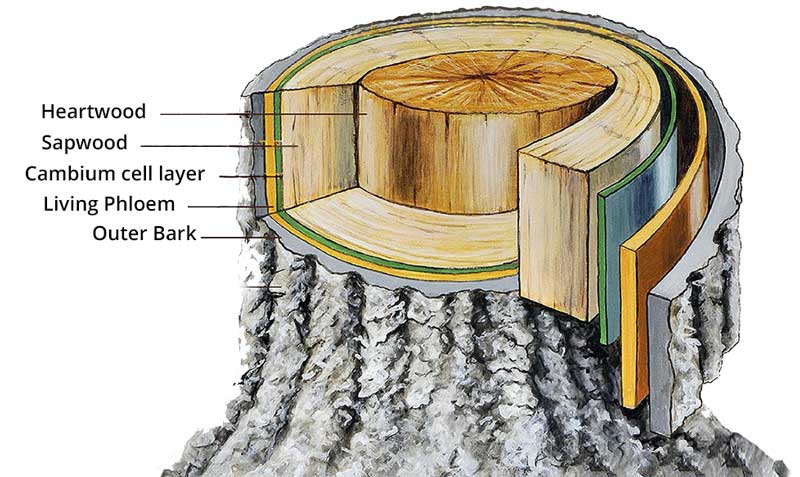How well do you know your trees? They play important roles, like providing oxygen and enhancing curb appeal in our yards, but trees are a mystery to many. Read on to understand what makes up a tree and what role each of its parts plays.
All trees have three main parts: the crown, trunk, and roots. Each of these parts plays its role in keeping the tree healthy and supporting the ecosystem. The crown is the most visible part of the tree, holding the branches while the trunk sits below it. The roots are the bottom, anchoring the tree to the soil.

What we cover
ToggleParts of A Tree
Each part of a tree plays an important role in the ecosystem and the tree’s health. Understanding each part and its importance can help you know how to keep your tree healthy.
Here are the eight main parts of a tree and their functions:
The Crown
Most people would quickly name the crown or at least describe it if asked about the main parts of a tree. Yes, the crown is the most visible and one of the main parts of a tree. The crown is the top portion of any tree where all the branches, leaves, and even fruit reside.
The crown starts right where the first branches emerge from the trunk. It’s the part that, perhaps, influences how a tree functions and its appearance. Some trees have wide crowns with a dense canopy and are excellent as shade trees, while others have tall but narrow crowns.
Thanks to existing knowledge of tree structures, you can easily tell which tree to plant based on your needs. For instance, you can go for an oak tree if you are looking for a shade tree because it will develop a spreading crown with densely leaved branches.
There are five common types of tree crowns1 with each having a distinct shape and characteristics as listed below:
Weeping crown – Weeping crowns have thin branches that droop downwards. Examples include willow trees, white birch trees, White mulberry, Camperdown elm, etc. They are a great choice for landscaping due to their appearance and shade.
Full-Crowned – Full crowns have an even number of branches and a balanced shape. They are also good as shade trees and some, like sugar maple, are aesthetically pleasing.
Pyramidal Crown – Pyramidal crowns are wide at the base and thin out towards the top taking the shape of a pyramid. Some have branches starting at the bottom near the roots hiding most of the trunk. Common trees with pyramidal crowns include bald cypress and American linden.
Spreading Crown – Trees with spreading crowns are much wider than they are tall hence why they are usually the best choice as shade trees. They are usually multi-stemmed and have short but thick trunks. A good example of a tree with a spreading crown is the oak tree. Aside from the spreading crown, you can identify an oak tree with lobed leaves and its fruit, the acorn.
Columnar Crown – Trees with columnar crowns usually have upright canopies and short side branches that are of the same length. The tree takes the shape of a column because it is tall and narrow. They are perfect for landscaping, especially when planted on both sides of the road or driveway because of their uniform shape. Examples of trees with columnar crowns include Italian cypress, red maple, and poplar.
Other less common crow types include fountain crowns, layered crowns, and vase crowns.
The tree crown has many important functions, among them light energy assimilation, photosynthesis, absorbing carbon dioxide, flowering, producing fruit, producing oxygen, providing shade, etc.
Branches
Branches form part of the crown. They grow out of the stem or tree trunk, but other branches grow from bigger ones. It is from the branches that leaves, flowers, and fruits develop. Branches have multiple functions on most trees, with the main ones supporting the leaves and fruits and transporting nutrients to and from the trunk.
Depending on the type of tree, branches may also have other functions, like providing structural support for the entire tree. The shape and size of branches are also important for landscaping purposes, depending on the intended use. For instance, trees with large and long branches are usually not ideal where there is limited space between the tree and nearby structures.
They are different types of branches, but the main ones are boughs and twigs. Boughs are large branches, while twigs are smaller branches.
Boughs are directly connected to the trunk of a tree, while twigs can develop from other large branches. Smaller branches known as sprigs also develop out of twigs in some species. Other terms used to refer to tree branches include scaffold and lateral branches.
Leaves
In most species, the leaf is the terminal component at the upper section. Leaves are flattened structures growing out of a branch. They are usually blade-like and green in color although some do change color and pigmentation according to the season or weather conditions.
Considering their crucial functions, leaves are, perhaps, the most important components in most trees. They are responsible for transpiration and photosynthesis. It is the leaves that absorb carbon dioxide from the atmosphere and also produce oxygen. The same leaves utilize the sun to manufacture necessary nutrients for the tree through photosynthesis.
Leaves can be categorized in many different ways. They can be categorized according to an arrangement where we have alternate, whorled, and opposite. Leaves can also be identified or categorized according to their shape or appearance. For example, we have simple and compound leaves with the former referring to leaves without distinct leaflets and the latter referring to those with distinct leaflets.
Main Leader
The main leader or central leader in most trees is the vertical stem above the trunk that holds scaffold branches. The central leader is part of the crown and holds all the upper components (branches, leaves, and fruits).
When pruning, it’s important to identify the main leader and avoid cutting it as it forms the main support and plays an important role in the overall health and shape of the tree. Cutting the main leader will also restrict the tree to a certain height. Some trees have split central leaders while others may have multiple.
Trunk
The trunk is the vertical section of any tree connecting the tree to the roots and supporting the crown. Depending on the species, tree trunks can be thick and tall, thin or short and thick. Some species have branches covering most of the trunk.
Tree trunks have several functions with the most important ones being providing support and transportation of materials between the crown and roots. Some trunks also act as storage for water and nutrients.
Root Collar
The root collar is the area where the root system joins the trunk or main stem. It is essentially part of the trunk but has additional functions of holding the roots and facilitating the movement of water and nutrients between the trunk and roots.
The root collar requires the movement of carbon dioxide and oxygen in and out of its inner bark to stay healthy. This is why arborists often do something called root collar excavation during tree maintenance to keep the tree healthy.
Stability Roots
Stability roots go deep into the soil and provide crucial support to the entire tree. They are the thickest roots on any tree and tend to spread wide or go very deep into the soil. Trees depend on them to stay standing even in loose soil or bad weather. A tree with rotten or underdeveloped stability roots can easily tip over in bad weather.
Feeder Roots
Feeder roots are the opposite of stable roots in terms of size and placement and also play a different but equally important role. Feeder roots are the smaller, thinner but more densely formed roots that are primarily responsible for water and nutrient absorption from the soil. Feeder roots can develop from bigger support roots.
Layers of A Tree
Trees also have layers and each of them has a unique function. Here are the main layers found on most mature trees:

Heartwood
The heartwood is the central and supporting pillar of a tree. It may appear dead but the heartwood is usually quite strong, resistant to pests and decay, and less prone to chemicals or tree diseases. Heartwood is essentially the spine of the tree and is usually dark in color.
Sapwood
After the heartwood is a ring of wood referred to as sapwood. Sapwood consists of recently formed wood lying between the heartwood and the inner bark. It is the largest layer in terms of mass and diameter. It is through sapwood that water and nutrients pass through towards the crown as it is soft and “alive”. Some trees also store excess food in the sapwood. Sapwood is lighter in color as compared to heartwood.
Cambium
This is the secondary growing layer of a tree trunk and is positioned between the sapwood and phloem. The cambium layer may appear dead but it consists of actively dividing cells that are utilized by other actively growing layers.
Phloem
This layer consists of living tissues in the trunk and is placed between the cambium and outer bark. The phloem has multiple functions, the key among them being to transport and distribute organic nutrients formed through photosynthesis in a process referred to as translocation.
Outer bark
As its name suggests, the outer bark is the outermost layer of a tree trunk and is made up of dead tissue. The outer bark protects the inner layers from the elements such as the fore, mechanical injury, and pests.
Note: The anatomy of a palm tree is very different from the above. See our palm tree anatomy breakdown here.
- Arbor Day Foundation, (2019) Tree Shape. <https://www.arborday.org/planning-selection-location> Accessed: 14-02-2024.




